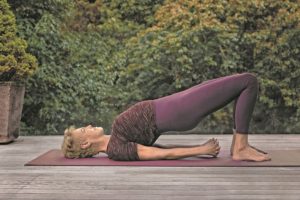I can feel September in the air. I like to think of this time of year as one of new beginnings. The light changes, and the crowds on the Cape thin out. The feeling has deep roots, too, winding back to memories of starting the new school year. It is a time to reset the body, mind, and spirit.
Bridge pose is known as setu bandhasana in Sanskrit, the language in which many ancient yoga texts were written — the original language of yoga. It means to form a causeway or bridge. Its shape reflects that meaning, but you might also think of it as a pose that makes a bridge from summer to fall.
To get into the pose, lie on your back on a yoga mat or a nonslip surface. Bend your knees and put your feet on the floor with your heels under your knees. Align your feet hip width apart — generally about six to eight inches, depending on your size. Now take a moment to feel your back on the floor. Make sure it is nice and long, from the tailbone to the crown of the head. Take a long slow breath in and then out to help you fully arrive and tune in to your body.

Pressing into your feet, lift your pelvis and hips toward the ceiling. Now let your hands find each other beneath the bridge you are forming. Interlock your fingers, bringing the wrists together to protect them from strain.
Lift your chest toward your chin and then lengthen the chin away from your chest. Draw your hands down, reaching toward your buttocks — you’ll find this opens the chest. Imagine you are gently squeezing a ball between your thighs to keep your legs active and in alignment with your hips rather than turning out. Hold this pose for a few breaths.
While holding a pose, I like to use breathing as a way of counting. When you hold a pose it can be tempting to hold your breath, too.
You may place a bolster or a block under your pelvis for a more restorative version of this pose. If you’d like extra cushioning for your shoulders, place a folded blanket under them.
But before you put your mat on the floor, it’s important to note that this pose is not recommended for anyone who has recent or chronic neck, shoulder, or back injury, inflammation, or pain. If you have even mild problems with your lower back, precautions are in order: be sure to breathe as you move in and out of this posture and to stop if you feel pain. Some sensation is part of the practice, but please don’t continue if you feel sharp pain or tingling “electric” sensations in the neck, back, or shoulders. Those are signs you need to back off, do less, or get out of the pose.
Bridge pose is a leg strengthener and a chest opener. It’s a way of opening our hearts and grounding ourselves at the same time. Which is why I think it’s such a fitting pose for this moment: beginnings and change bring uncertainty, which can be uncomfortable.
Discomfort at times of change is natural. Neuroscientists say we humans have a “negativity bias,” our brains constantly scanning for danger. We pull inward in anticipation of it. And we pay more attention to negative events in our lives and remember them more than positive things.
It’s a strategy that must have worked well for primitive man, when the mere act of survival was primary. But it can lead us modern folks into anxiety and depression.
We can counteract that by focusing on the good things and letting ourselves really experience them in our bodies. Bridge pose is great for practicing that. By grounding ourselves and opening the chest, we are inviting in fresh energy and positivity, staying present with the new.
This can help us to find more balance and compassion, something the Dalai Lama talks about. Compassion is, he has said, “the radicalism of our times.” Perhaps it is not easy, but it is a way to become less reactive and more tolerant and open to the future — or even just the season ahead.



